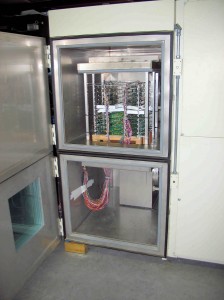 Thermal shock testing also called temperature shock testing or temperature cycling exposes products to alternating low and high air temperatures to accelerate failures caused by repeated temperature variations during normal use conditions. The transition between temperature extremes occurs very rapidly during thermal shock testing, greater than 15 °C per minute. Alternatively, temperature cycle testing uses slower rates of change between high and low temperatures. The failure acceleration rate for thermal shock testing is determined by the Coffin-Manson equation as previously discussed in DES’s blog article Temperature Cycling Testing: Coffin-Manson Equation.
Thermal shock testing also called temperature shock testing or temperature cycling exposes products to alternating low and high air temperatures to accelerate failures caused by repeated temperature variations during normal use conditions. The transition between temperature extremes occurs very rapidly during thermal shock testing, greater than 15 °C per minute. Alternatively, temperature cycle testing uses slower rates of change between high and low temperatures. The failure acceleration rate for thermal shock testing is determined by the Coffin-Manson equation as previously discussed in DES’s blog article Temperature Cycling Testing: Coffin-Manson Equation.
Equipment with single or multiple chambers may be used to perform thermal shock testing. When using single chamber thermal shock equipment, the products or samples remain in one chamber and the chamber air temperature is rapidly cooled and heated. This usually results in a slower rate of change in the product response temperature as the entire chamber must be cooled down and heated up. However larger products can be tested in single compartment chambers. Some equipment uses separate hot and cold chambers with an elevator mechanism that transports the products between two or more chambers. This results in a more rapid rate of change in the air temperature. However, there is a limit to the size and weight than can be put in a chamber with an elevator mechanism. DES has both types of chambers for thermal shock testing.
When performing thermal shock testing, the upper and lower temperatures must be carefully determined. Larger differences between the test chamber temperatures and the product normal use temperatures will result in higher acceleration factors as determined from the Coffin-Manson equation. However, the correct temperature limits must be chosen to not exceed the operating limits or material property limits of the product. For example, an upper temperature that exceeds the melting point of any material in the product would likely result in invalid test failures. It is therefore important that these temperatures be properly measured and monitored during the test through the careful placement of thermocouples on and around the products or samples.
Factors that can influence the test parameters include the thermal mass of the samples, the number of samples and the airflow around the samples that depends on the sample spacing in the chamber. The dwell time at each temperature should be included in the test specification along with the tolerances around the high and low temperatures. Test methods may also specify minimum rates of temperature change.
Products may be powered or unpowered during the thermal shock test. Products that are powered during the test need cables that are long enough to reach outside of the chamber and can fit inside the chamber feed through.
Delserro Engineering Solutions, Inc. (DES) has many years of experience performing thermal shock testing and can assist customers in setting up a test using the proper test conditions. So if you do not know what test conditions that you should use or what specification to choose, then we will help you because we are thermal shock testing experts!
Examples of some common thermal shock test specifications include:
- MIL-STD-202, Method 107, Thermal Shock
- MIL-STD-810, Method 503, Temperature Shock
- MIL-STD-883, Method 1010, Temperature Cycling
- JESD22-A104D, Temperature Cycling